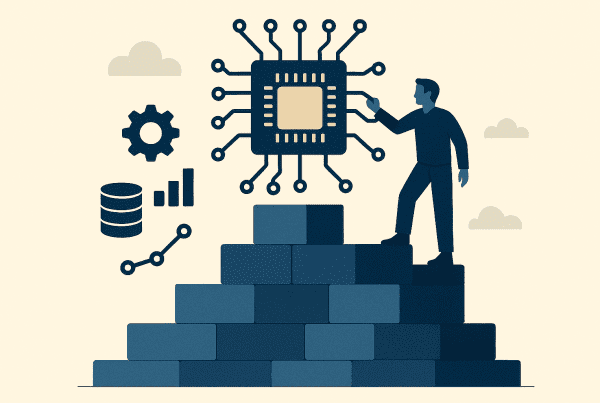The manufacturing industry is undergoing a digital transformation, with AI in manufacturing revolutionizing production processes and enabling smart factory operations. Data science plays a crucial role in this transformation, providing analytical and predictive techniques that power AI-driven improvements in efficiency and quality. AI can analyze large volumes of data from sensors and production lines to optimize efficiency and improve quality.
Manufacturing leaders are embarking on an AI journey, moving from initial exploration and experimentation to advanced deployment of AI solutions. From predictive maintenance to automated quality control, AI drives efficiency and innovation.
But before implementing AI, leaders face a critical question: Should you deploy AI in the cloud or on-premises? This decision impacts cost, security, performance, and scalability. For guidance and reliable technology support, let’s explore what manufacturing executives need to know.
Understanding the Two Models
Cloud AI is a cloud-based AI solution hosted by cloud providers such as Microsoft CoPilot, AWS, Azure, or Google Cloud and accessed via the internet. It offers rapid deployment, elastic scalability, and subscription-based pricing. Manufacturers can leverage advanced AI without significant investments in hardware and infrastructure. Cloud-based AI enables fast analysis and more profound insights by facilitating seamless data integration, making it a powerful tool for modern manufacturing.
On-Prem AI, on the other hand, is an on-premises AI deployment model that runs within your own on-premises infrastructure, such as your data center or factory floor. It provides complete control over data and systems, which is crucial for highly regulated industries. However, on-premises AI requires significant hardware investments and ongoing maintenance.
Quick Pros and Cons:
- Cloud AI: Lower upfront cost, faster innovation, but dependent on connectivity.
- On-Prem AI: Greater control, lower latency, higher CapEx and IT resource requirements.
Cost Considerations
Cost is often the first factor in the debate over AI deployment models in manufacturing.
- Cloud AI uses an OpEx model—predictable monthly costs, pay-as-you-go flexibility, and minimal hardware investment. Cloud-based AI is often more cost-effective than traditional hardware solutions because it reduces upfront capital expenses and optimizes ongoing operational costs.
- On-Prem AI demands CapEx—enormous upfront costs for servers, GPUs, and networking, as well as ongoing maintenance.
Pro Tip: Calculate the total cost of ownership for AI systems over 3–5 years. While the cloud seems cheaper initially, subscription fees can add up. On-prem may offer better ROI if workloads are stable and predictable.
Data Security and Compliance
The AI debate for manufacturing often involves sensitive intellectual property and customer data.
- Cloud AI providers invest heavily in security certifications and encryption. Still, you must trust third-party compliance, carefully consider data privacy, and evaluate potential risks related to third-party access and regulatory requirements. Cloud-based AI enhances security by proactively identifying and mitigating potential risks through continuous monitoring, offering an additional layer of protection for sensitive operations.
- On-Prem AI gives you complete control, making it easier to meet AI compliance requirements in industrial settings such as ISO 27001 or GDPR, and is often preferred by organizations handling sensitive data and information that require strict protection and access controls.
Key Question: Does your AI solution align with your industry’s regulatory requirements and internal security policies, and support managed IT workflows?
Performance and Latency
Real-time production environments demand speed.
- Cloud AI may introduce delays due to network dependencies, disrupting time-sensitive operations.
- On-Prem AI latency performance is ideal for tasks that require millisecond responses, such as robotic control, defect detection, and real-time decision-making for applications like computer vision and digital twins. On-prem AI enables the use of advanced AI algorithms and machine learning for immediate decision-making on the factory floor, SST, and other operations that require its accuracy. AI systems analyze sensor data from machinery to forecast failures before they occur, reducing unexpected downtime and ensuring smoother operations.
Solution: Consider edge computing for real-time AI—processing data locally while leveraging cloud for analytics and model updates. For robust protection against cyber threats in such distributed environments, consider learning more about the benefits of ethical hacking for your business.
Scalability and Flexibility
Manufacturing workloads fluctuate.
- Cloud AI scalability benefits allow you to scale up during peak demand without buying new hardware. Cloud AI provides on-demand access to AI tools and resources, enabling manufacturers to adapt quickly to changing requirements. This scalability supports operational efficiency and helps manufacturers plan future needs by analyzing data and optimizing resource allocation. Cloud-based AI can help organizations anticipate future needs by analyzing historical data, providing more profound, more actionable insights.
- On-Prem AI scaling requires physical upgrades, which can be costly and slow.
Integration Tip: Ensure your AI integrates with MES and ERP systems for seamless operations across the factory floor.
Reliability and Uptime
Downtime in manufacturing can be expensive.
- Cloud AI depends on internet connectivity—outages can halt operations.
- On-Prem AI risks hardware failures but offers local control.
Best Practice: Implement AI disaster recovery planning for both models, including backup systems and failover strategies. Incorporate continuous monitoring and robust risk management practices to minimize downtime and operational risk, ensuring reliability in both cloud and on-prem AI deployments.
Skills and Resource Requirements
- Cloud AI reduces internal burden but requires vendor management and staff training to work efficiently in a cloud environment.
- On-Prem AI demands in-house IT expertise for setup, monitoring, and troubleshooting. Deploying on-prem AI also requires access to high-performance computing resources and effective management to guide employees through the transition and retraining process.
Ask yourself: Do you have the resources to maintain on-prem infrastructure, or would outsourcing to a cloud provider free up your team?
Hybrid Approaches
Many manufacturers adopt hybrid AI solutions for manufacturing, combining cloud scalability with on-prem control for critical workloads. Example: Use on-prem for real-time production analytics and cloud for predictive maintenance and supply chain optimization.
Long-Term ROI and Strategic Alignment
Which model supports your goals for digital transformation with AI?
Many organizations and businesses are adopting hybrid AI approaches to balance control, security, and flexibility. Most organizations begin their AI journey with cloud-based solutions for faster deployment and lower upfront investment, then transition to hybrid or on-premises models as their organization’s needs and AI maturity evolve.
Manufacturing companies, in particular, benefit from adopting AI through hybrid approaches, optimizing maintenance schedules, and reducing downtime on assembly lines. AI enables manufacturers to offer mass customization, tailoring products to individual customer preferences, and further enhance customer satisfaction and operational efficiency.
- Cloud AI accelerates innovation and adapts to changing business needs.
- On-Prem AI may align better with strict compliance and control requirements.
Tip: Align your choice with your 3-to-5-year roadmap, not just immediate needs.
Key Questions to Ask
Before signing a contract, clarify:
- SLAs and uptime guarantees. Cloud AI services and service offerings enable organizations to quickly deploy AI applications and AI technologies to perform tasks that drive innovation and efficiency.
- Upgrade paths and support.
- Avoiding vendor lock-in with AI platforms—can you easily migrate your data if you switch providers?
Tip: Making informed decisions about AI deployment—such as exploring a document management system for your organization—is crucial to support your organization’s AI initiatives and ensure long-term strategic alignment.
So, What’s Right for You?
Choosing between cloud AI vs on-prem AI is a technical yet strategic decision. Consider cost, compliance, performance, and scalability to ensure your AI investment drives long-term value. For some manufacturers, a hybrid approach offers the best of both worlds.
Connect with Atlantic today to learn more about how we can help you find the right AI deployment strategy that exceeds your goals.
About Atlantic, Tomorrow’s Office
Atlantic, Tomorrow’s Office is a leading managed services provider offering managed IT, cybersecurity, office technology, business consulting, and digital transformation solutions. Focusing on helping mid-market businesses optimize their cybersecurity practices, enabling technology and operations, Atlantic delivers end-to-end solutions tailored to the evolving needs of today’s enterprises. For more information on Atlantic and its expanded business consulting services, visit www.tomorrowsoffice.com.





